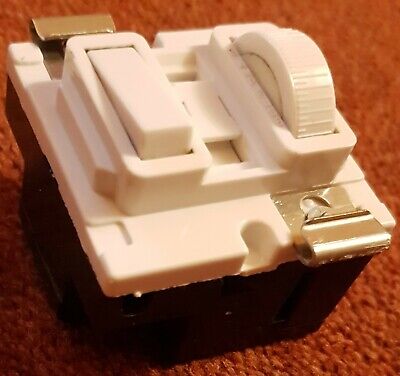L
Lucien Nunes
What is the oldest dimmer switch you have seen in use recently?
When did you install your first dimmer? (Veteran sparks only)
I ask because a friend recently sent me a link to a 'news' story about an old toaster still in use, which I don't even really see as an old toaster (OK, yes, it's older than my daily use toaster but I have much older working toasters.) There are quite a few of these stories around, where people find something from the 1950s still giving service and think that's remarkable. But what about the humble, unobtrusive knob on the wall?
I have one old dimmer still in use at home, it's a 'Crescent 2' 300W model which probably dates from the late 1960s. I haven't been able to pin it down any tighter from the components, but if I trawl some magazines of the era I think there are ads for this specific dimmer. Mounted on MK rounded corner face plates, they use an old circuit based on a stud thyristor inside a bridge rectifier, triggered by a germanium transistor, instead of a triac triggered by a diac which has been standard since the 1970s. This has the disadvantage of two extra diode-drops so higher heat dissipation, but the advantage of absolute firing symmetry. I see flicker very easily and can spot a diac-triggered triac dimmer that has a 50Hz component in its output due to slightly different triggering voltages on the two half-waves.
We had five of these at one time, some were retired with the coming of the CFL, another replaced with an IR remote-controlled one, etc. One did fail with a leaky AC128. The last one is likely to get retired soon as I want to try LED in this fitting that is on for many hours a day and will need a compatible dimmer. At the moment the Crescent 2 is dimming a 150W GLS lamp, it has had up to 200W (often 2x 100W in a bayonet Y-adaptor) as it's a key light source in the lounge. The main reason the Crescent has survived so long is the high quality Allen-Bradley pots they used, which never seem to wear out.
Let's see your old dimmers. I have a soft spot for the edge-thumbwheel-controlled MKs of the 70s-80s with the separate switch. I don't think we have any in the collection though.



When did you install your first dimmer? (Veteran sparks only)
I ask because a friend recently sent me a link to a 'news' story about an old toaster still in use, which I don't even really see as an old toaster (OK, yes, it's older than my daily use toaster but I have much older working toasters.) There are quite a few of these stories around, where people find something from the 1950s still giving service and think that's remarkable. But what about the humble, unobtrusive knob on the wall?
I have one old dimmer still in use at home, it's a 'Crescent 2' 300W model which probably dates from the late 1960s. I haven't been able to pin it down any tighter from the components, but if I trawl some magazines of the era I think there are ads for this specific dimmer. Mounted on MK rounded corner face plates, they use an old circuit based on a stud thyristor inside a bridge rectifier, triggered by a germanium transistor, instead of a triac triggered by a diac which has been standard since the 1970s. This has the disadvantage of two extra diode-drops so higher heat dissipation, but the advantage of absolute firing symmetry. I see flicker very easily and can spot a diac-triggered triac dimmer that has a 50Hz component in its output due to slightly different triggering voltages on the two half-waves.
We had five of these at one time, some were retired with the coming of the CFL, another replaced with an IR remote-controlled one, etc. One did fail with a leaky AC128. The last one is likely to get retired soon as I want to try LED in this fitting that is on for many hours a day and will need a compatible dimmer. At the moment the Crescent 2 is dimming a 150W GLS lamp, it has had up to 200W (often 2x 100W in a bayonet Y-adaptor) as it's a key light source in the lounge. The main reason the Crescent has survived so long is the high quality Allen-Bradley pots they used, which never seem to wear out.
Let's see your old dimmers. I have a soft spot for the edge-thumbwheel-controlled MKs of the 70s-80s with the separate switch. I don't think we have any in the collection though.



Last edited by a moderator:






 Could never really see the point in why you'd want to have more than one light in the same room switched together with one dimming and the other/s staying at full wallop ?
Could never really see the point in why you'd want to have more than one light in the same room switched together with one dimming and the other/s staying at full wallop ?











